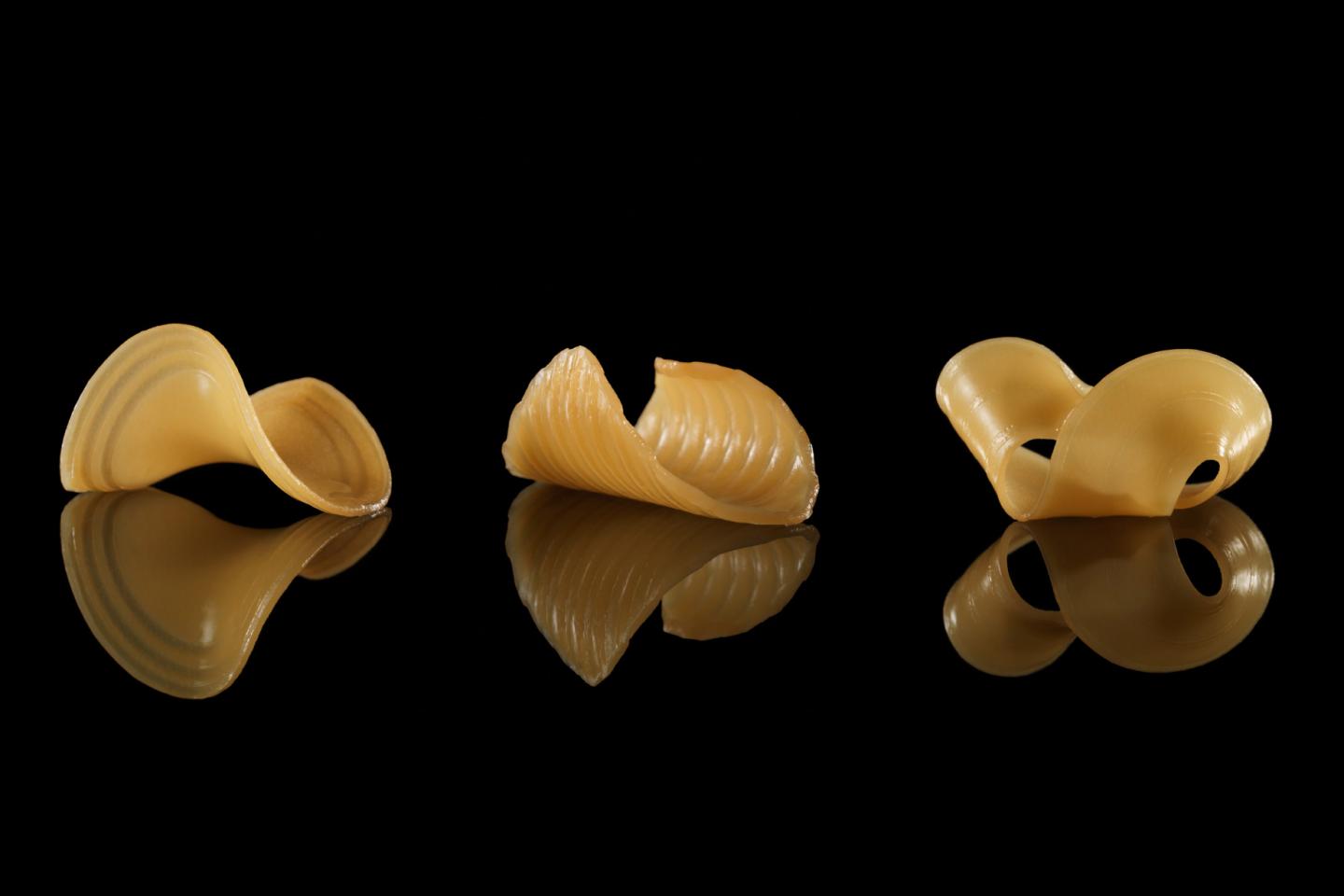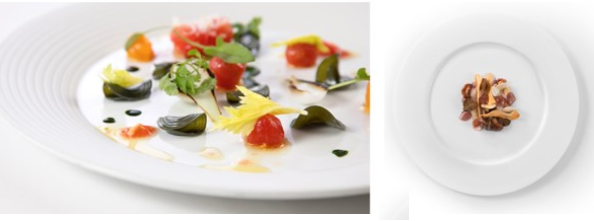Are you ready for pop-up, shape-shifting food? Just add water.
June 3, 2017

Fun with food: These pasta shapes were generated by immersing a 2D flat gelatin film into water. (credit: Michael Indresano Photography)
Researchers at MIT’s Tangible Media Group are exploring ways to make your dining experience interactive and fun, with food that can transform its shape by just adding water.
Think of it as edible origami or culinary performance art — flat sheets of gelatin and starch that instantly sprout into three-dimensional structures, such as macaroni and rotini, or the shape of a flower.
But the researchers suggest it’s also a practical way to reduce food-shipping costs. Edible films could be stacked together, IKEA-style, and shipped to consumers, then morph into their final shape later when immersed in water.
“We did some simple calculations, such as for macaroni pasta, and even if you pack it perfectly, you still will end up with 67 percent of the volume as air,” says Wen Wang, a co-author on the paper and a former graduate student and research scientist in MIT’s Media Lab. “We thought maybe in the future our shape-changing food could be packed flat and save space.”
Programmable pasta, anyone?
At MIT, Wang and associates had been investigating the response of various materials to moisture. They started playing around with gelatin (as in Jello), a substance that naturally expands when it absorbs water. Gelatin can expand to varying degrees depending on its density — a characteristic that the team exploited in creating their shape-transforming structures.
They created a flat, two-layer film made from gelatin of two different densities. In theory, the top layer was more densely packed, so it should be able to absorb more water than the bottom layer. Sure enough, when they immersed the entire structure in water, the top layer curled over the bottom layer, forming a slowly rising arch — creative pasta.*

Culinary performance art by MIT researchers. (left) Phytoplankton pasta salad with heirloom tomatoes and wild Sorrel. (right) Flowering pasta with west-coast foraged mushrooms
and fermented burgundy truffle. (credit: Michael Indresano Photography)
To see how their designs might be implemented in a professional kitchen, the researchers showed their engineered edibles to Matthew Delisle, the head chef of high-end Boston restaurant L’Espalier. They jointly designed two culinary creations: transparent discs of gelatin flavored with plankton and squid ink, that instantly wrap around small beads of caviar; and long fettuccini-like strips, made from two gelatins that melt at different temperatures, causing the noodles to spontaneously divide when hot broth melts away certain sections. “They had great texture and tasted pretty good,” Yao says.
DIY food
The researchers used a laboratory 3-D printer to pattern cellulose onto films of gelatin. But they suggest users can reproduce similar effects with more common techniques such as “screen printing” in an open-access paper presented at the Association for Computing Machinery’s 2017 Computer-Human Interaction Conference on Human Factors in Computing Systems (CHI 2017).
They envision that their “online software can provide design instructions, and a startup company can ship the materials to your home,” Yao says.
This research was funded, in part, by the MIT Media Lab and Food + Future, a startup accelerator sponsored by Target Corporation, IDEO, and Intel.
* The team recorded the cellulose patterns and the dimensions of all of the structures they were able to produce, and also tested mechanical properties such as toughness, organizing all this data into a database. Co-authors Zhang and Cheng then built computational models of the material’s transformations, which they used to design an online interface for users to design their own edible, shape-transforming structures.“We did many lab tests and collected a database, within which you can pick different shapes, with fabrication instructions,” Wang says. “Reversibly, you can also select a basic pattern from the database and adjust the distribution or thickness, and can see how the final transformation will look.”
Tangible Media Group | Transformative Appetite
Abstract of Transformative Appetite: Shape-Changing Food Transforms from 2D to 3D by Water Interaction through Cooking
We developed a concept of transformative appetite, where edible 2D films made of common food materials (protein, cellulose or starch) can transform into 3D food during cooking. This transformation process is triggered by water adsorption, and it is strongly compatible with the ‘flat packaging’ concept for substantially reducing shipping costs and storage space. To develop these transformable foods, we performed material-based design, established a hybrid fabrication strategy, and conducted performance simulation. Users can customize food shape transformations through a pre-defined simulation platform, and then fabricate these designed patterns using additive manufacturing. Three application techniques are provided – 2D-to-3D folding, hydration-induced wrapping, and temperature-induced self-fragmentation, to present the shape, texture, and interaction with food materials. Based on this concept, several dishes were created in the kitchen, to demonstrate the futuristic dining experience through materials-based interaction design.